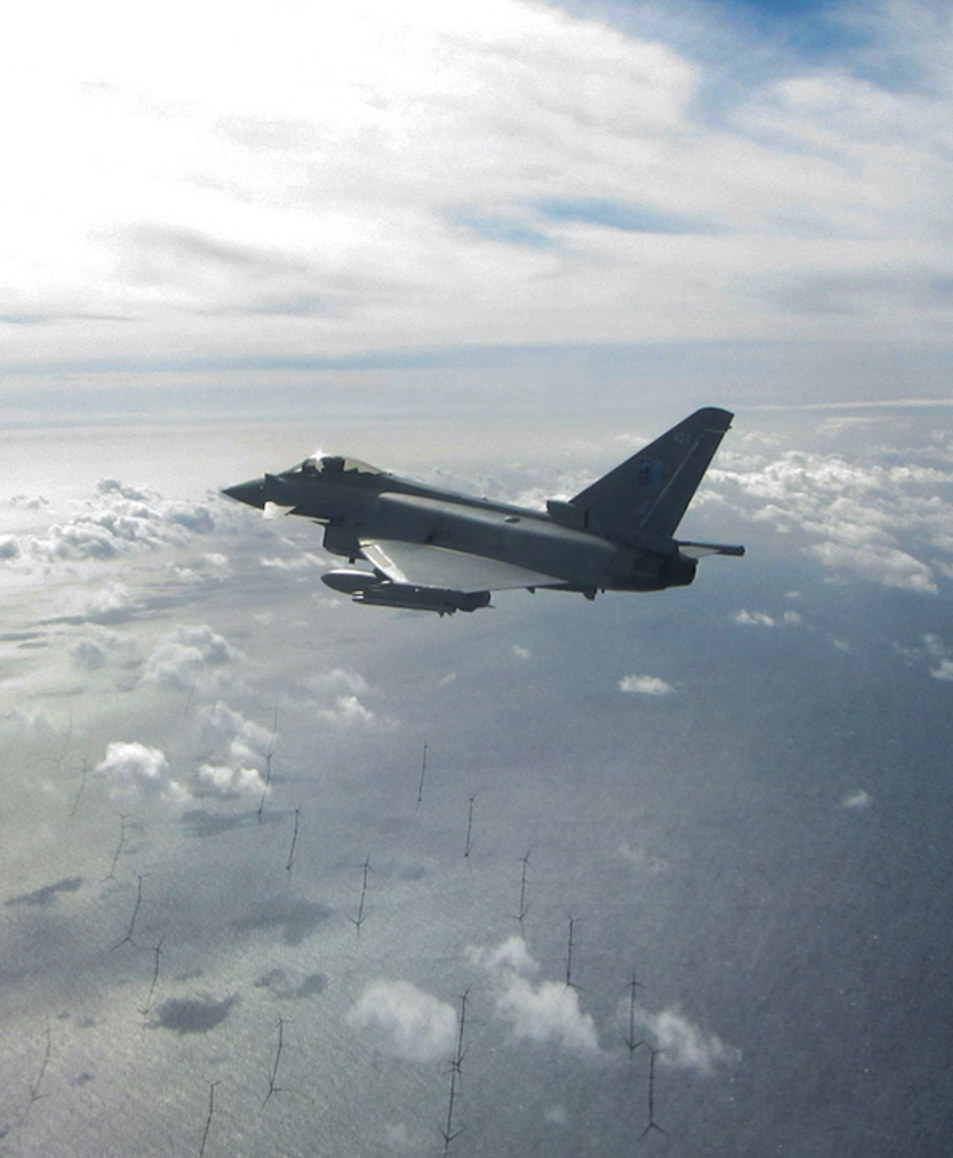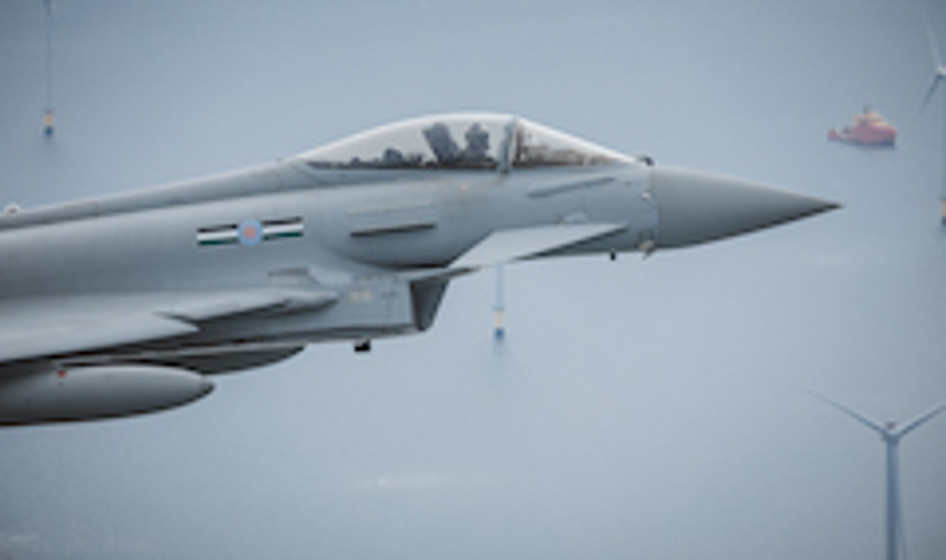
Last September the UK Government announced that it was handing out £3.8 million (US$5.4 million) in grants to fund the development of technologies aimed at mitigating the radar risk posed by offshore wind farms.
The competition was overseen by the UK Ministry of Defence (MOD) and the Offshore Wind Industry Council Air Defence Mitigation Task Force, a body set up to support the coexistence of offshore wind farms and UK air defense systems.
Wing Commander Kevin Walton, who co-chairs the task force, says that for in the line of sight of radar “offshore wind farms have a detrimental effect on primary surveillance radar capability used to deliver a recognized air picture for air defense”.
“Radar returns from within-radar line of sight wind turbines comprise reflections from both the static and moving elements, each providing different challenges for the radar,” says Walton.
“The reflections from the stationary towers can swamp a radar receiver and have the effect of reducing its sensitivity, so that it can no longer detect aircraft whose radar cross-sections are much smaller than the wind farm tower itself.”
In addition, since the moving blades of the wind turbine “have radar cross sections similar to an aircraft,” the receiver can be confused into mistaking the moving blade for an aircraft, says Walton.
What's more, since modern radars track individual radar returns over time to create the aircraft tracks that an operator sees, the moving wind turbine blades can create false tracks.
Clutter
The result of all these issues is to create visual interference – known as clutter – on the radar operator's display, which makes it much harder to identify genuine aircraft, Walton says.
Radar clutter from wind farms is far from a new problem, but the increasing size and scale of wind farm developments means that the solutions created in the past are becoming obsolete, says Steve Smith, wind farm sector lead for the radar surveillance division of the French multinational aerospace company Thales.
“The traditional solution has been to try and avoid the problem,” says Smith. “You stop wind farms being built near your airport. You create exclusion zones with nothing within, say 20 miles. Or you have blanking areas where you turn off the radar returns coming from that particular area because there is too much content.”
However, the sheer size of modern wind turbines is making them harder to ignore, says Smith.
“Onshore wind turbines are maybe 180m in height, but offshore they are heading for up to 350m high,” says Smith. “When you have a 1.5GW wind farm, about the size of a nuclear power station offshore in terms of energy, it will include about 100 wind turbines and cover an area of about 400km2.”
Turning off the radar returns for a wind farm of that scale is not feasible because “it means you lose data information on a very large area, which is unacceptable from an air traffic controller point of view,” says Thomas Delalande, business development manager for ATC radar at Thales.
Another mitigation tactic – locating wind farms away from areas where they might cause interference, is also becoming increasingly untenable, given the explosion in wind farm development globally as countries attempt to honor commitments to tackle climate change. The UK for example has committed itself to reaching 40GW of power from offshore wind by 2030 – four times its current output – and hopes to be net zero by 2050, a goal that could require up to 140GW of offshore wind, says William Apps, head of energy development at the Crown Estate, which owns most of the UK's coastal waters.
“Given the pipeline of projects coming forward, it was recognized under the offshore wind sector deal that a more strategic approach to addressing mitigation across the UK was needed,” says Apps, who also sits on the mitigation task force.
Software solution
To counter the problem, Thales has developed an integrated software solution that Smith says can filter out wind farm interference. “The software is a sophisticated set of algorithms called the wind farm filter,” says Smith.
The technology works by first identifying the location of a wind turbine, says Smith.
“One of the nice characteristics of wind farms is that the turbines do not move,” he says. “Because of this we can know very precisely, within less than a meter, where the turbine is.”
Using this high level of precision the algorithms can account for and filter out the turbine without needing to turn off radar returns for the rest of the wind farm's zone.
“The area we filter out is a very controlled area, very local to the wind turbine,” says Smith. “Everything outside of that is normal.”
The filter can be turned on and off as needed, he says. “You don't have to apply it to every wind farm in the line of sight, only the ones where the operator is getting interference.”
The solution is not only remedial. Thales’ engineers can also use modeling tools to simulate how a proposed wind farm project may impact a specific airport's radar systems.
Through this modeling they can help airports understand the type of radar they need, including the size and configuration. This gives them the confidence to confirm with developers that a site does not pose a risk.
The solution is in place at several European airports. already. Smith says, “We are conducting trials with military and civil authorities to demonstrate that as it scales up, the solution works for much larger wind farms.”
Defense competition
Wind farm interference is more of a problem for air defense than it is for civilian radar, according to Walton. This is because unlike civil aviation, military radar systems cannot rely on cooperative radar, which picks up broadcasts emitted from an aircraft's on-board transponders.

They rely instead on primary radar, which tracks aircraft independent of any on-board systems. This means that a primary radar system will see an object but cannot know for sure whether that object is an aircraft.
Consequently, it is more likely that a primary radar system could mistake clutter – wind farms, for example – for an aircraft.
“Air defense staff cannot rely on transponder data, standard flight paths, and standard flying heights of potential enemy aircraft, who may intend to remain hidden,” says Walton. “For air defense it is necessary to be able to detect aircraft even if they are trying not to be seen. This means we are unable to rely on aircraft cooperating by following set procedures.”
Walton and his team selected seven technologies to fund as part of the UK Government's wind farm mitigation competition. The technologies that are being developed for the competition include a holographic radar system and a system incorporating machine learning and artificial intelligence techniques.
The entrants include two technologies developed by Thales, projects by the aerospace company Saab and three UK technology companies.
Walton says, “We have looked at a range of technologies as part of our innovation challenge and the concept demonstration program.
“All potential approaches remain on the table and the MOD will launch a formal procurement competition in due course.”
Alongside the innovation competition, Walton's task force has completed a program of concept demonstrations funded by the wind farm sector and delivered by the MOD. The demonstrations have tested the performance of mitigation solutions available to support the wind farms expected from 2025 onwards.
Walton says, “The joint task force has determined that one or more technical mitigation solutions will be available in the timescales that are needed for the next generation of wind farms. This work will also help us to develop the formal requirements against which we would procure mitigation solutions.”
While the task force's work is confined to the UK, wind farms interfering with radar is a problem across the world. “This is happening everywhere,” says Delalande, citing as evidence a recent meeting he had to discuss a deployment of the mitigation technology in Asia.

The international scope of the challenge means the UK-based task force has been in discussions with various NATO bodies, including the Centre of Excellence for Climate Change as well as with a number of individual NATO nations.
Walton notes that “the continued importance of a strong and effective air defence system for the UK homeland has also been brought in to sharp focus with the events in Ukraine”.
Or as Smith says, “Aircraft that may come to visit us without permission from other states are non-cooperative. They don't turn on their transponders and let us know they are coming. So the capability of removing that complex clutter from the display and leaving the operator with the moving target is really a core part of primary surveillance protection.”
